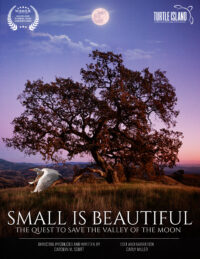Maybe. According to a recent Superior Court ruling, that’s about all the Sonoma County Water Agency’s Urban Water Management Plan (UWMP) can be sure of in terms of its future water projections – and the City of Sonoma is taking the ruling seriously.
“We want to have a new look on our general plan assumptions, given the new information around water,” said then-mayor Joanne Sanders. To this end, she has scheduled what she calls a “water pow wow” for 6 p.m. Wed. Dec. 10, in the Community Center, that will open a public discussion about how to manage the city’s water future when the county’s projections, summarized in the Superior Court ruling, may be unreliable.
The petitioners of the lawsuit, consisting of 14 local conservation groups, allege that the plan fails to inventory, assess and allocate ground and surface water resources adequately and accurately, that it overlooks ground and surface water contamination, that it overstates water supplies, understates water demands, and therefore that it threatens to induce unsustainable urban development throughout the area. The court agreed.
Superior Court Judge Gary Nadler wrote, “While the [UWMP] identified a potential water shortfall by 2020, it relies on certain assumptions including constructing facilities for transporting the water; that Endangered Species Act considerations for salmonids would not present a problem, and that necessary licenses necessary to meet the shortfall will be obtained.” Further, the judge pointed out, the UWMP relies on voluntary actions and reduced allocation, as well as potentially petitioning the State Resources Control Board to relax temporary flow requirements in Russian River and Dry Creek to increase the supply of water.
“In a nutshell,” said Brenda Adelman, chair of the Russian River Watershed Protection Committee, “the issue is that they are projecting water for new development that they don’t have access to.”
Geologist Jane E. Nielson, Ph.D., President of the Sebastopol Water Information Group and member of the Sonoma County Water Coalition, agreed. “They really did not consider all the aspects regarding all that would happen as the county grows, and if the river is really over-promised. How much is taken out of the river even now is not known. There’s a lot of unpermitted water being extracted. And the impacts on the salmon haven’t been considered.”
Adelman continued, “They’re projecting having water they’ve been trying to get for 13 years, and it may be 13 years before they see it. They’re trying to increase their water permits to take from the Russian River and the water is stored behind two dams… but they haven’t been able to get their delivery.” Complicating matters is that when water is released from Warm Springs Dam, its velocity damages Dry Creek, causing erosion, sweeping away juvenile fish. This creates a set of problems that lead to the listing of three species and, said Adelman, a new biological opinion that will have the force of law, requiring modifications to the stream channel to spare the fish. “It’s very conceivable we’re going to have water crisis,” she said. “Now they’re talking about lowering the flows on the Russian River; so if they keep building new buildings with out having the water resources available it will be real crisis for everybody.”
“It’s just amazing fantasy,” said David Keller, Bay Area Director of Friends of the Eel River. ”If you’re going to make assumptions you’re going to have to back it up with substantial evidence. And they didn’t.” The situation he describes bears a resemblance to the larger-scale economic collapse. “Basically, at this point, in the upper Russian River, there’s more water taken out – legally or illegally – than naturally flows into it.”
Will Pier, who was narrowly missed unseating District One Supervisor Valerie Brown, said part of the problem is that the Sonoma County Board of Supervisors makes up the board of the Water Agency. “That to me is a really weak position for the county to be in.” He said usually water boards are made up of representatives specializing in water, and the elected supervisors. “I think it’s a very poorly created board,” he said. “It’s not that the county doesn’t know that they have to come into compliance with [Environmental Protection Agency] EPA. But that it’s going to cost a lot of money to do it.”
Brown said, “Right now our county counsel are drawing up the rationale for an appeal and we’ll make a decision on how we proceed next Tuesday.” She added that there are many difficulties complying with the judge’s requests. “One of the things was, we do a 25-year assessment, and we have to make certain assumptions on water supply, and Judge Nadler wanted us to do that with certainty. I wish we could. But that’s not really something we can do. Assumptions are sometimes all we have, in terms of projections of the future.”
The judge’s decision, said Stephan Volker, attorney for the plaintiffs, “will result in an order from the court that the agency prepare a new plan that will recognize that demand is outstripping supply… Land use planning agencies will have to tighten their belts and reduce their planned growth.”
That belt tightening, and water saving, and all other ideas will be welcome at the “water pow wow,” on Wednesday.
“Frankly,” said David Keller, “hats off to the judge for having waded through over 70,000 pages of public record. It’s just astonishing the amount of work that he did to reason this very, very carefully.”
Water Agency plan under fire
More from What's HappeningMore posts in What's Happening »
- Board of Supervisors boosts Sonoma County’s Living Wage to $23.15 per hour starting July 1
- Sonoma County Board of Supervisors pledges to safeguard civil rights of immigrants
- Small Is Beautiful Film About SDC to be Shown Sunday, January 19 at 2 PM
- Transition to District-Based City Council elections on the City’s Agenda for Jan. 15th




